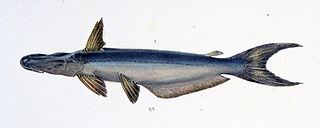 W
WAgeneiosus ucayalensis is a species of driftwood catfish of the family Auchenipteridae. It can be found in South America.
 W
WAnableps anableps, the largescale four-eyed fish is a species of four-eyed fish found in fresh and brackish waters of northern South America and Trinidad. This species grows to a length of 32 centimetres (13 in) TL. This fish can be found in the aquarium trade. The fish does not actually have four eyes, but instead each eye is split into two lobes by a horizontal band of tissue, with each lobe having its own pupil and separate vision. This allows the fish to see under and above the surface of the water at the same time.
 W
WThe Cetopsidae are a small family of catfishes, commonly called the whale catfishes.
 W
WCopella arnoldi, commonly known as the splash tetra or the splashing tetra, is a species of tropical freshwater fish belonging to the family Lebiasinidae. It is native to South America.
 W
WCrenicichla johanna is a species of cichlid native to South America. This species reaches a length of 28 cm (11 in).
 W
WGoeldiella eques is a species of three-barbeled catfish that occurs in the Guianas and the Amazon basin of Brazil, Peru and Venezuela. This fish reaches a length of 28.9 centimetres (11.4 in) SL. It is the only species of its genus.
 W
WHydrolycus armatus is a species of dogtooth characin found in freshwater of tropical South America. It is sometimes known as the payara, a name it shares with the related H. scomberoides.
 W
WHydrolycus tatauaia is a species of dogtooth characin found in the Amazon, Orinoco and Essequibo basins in tropical South America. Adults mainly occur in deep and/or fast-flowing rivers. It is migratory, moving upstream to breed in November–April.
 W
WHypostomus plecostomus, also known as the suckermouth catfish or the common pleco, is a tropical fish belonging to the armored catfish family (Loricariidae), named for the armor-like longitudinal rows of scutes that cover the upper parts of the head and body. Although the name Hypostomus plecostomus is often used to refer to common plecostomus sold in aquarium shops, most are actually members of other genera.
 W
WThe keyhole cichlid is a cichlid fish endemic to tropical South America, occurring in the lower Orinoco Basin in Venezuela and river basins in The Guianas. It is the only species in the genus Cleithracara. The species is popular with fishkeeping hobbyists and is frequently kept in aquariums.
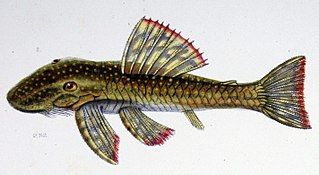 W
WLasiancistrus schomburgkii is a species of armored catfish native to Brazil, Colombia, Ecuador, Guyana and Peru. This species grows to a length of 14.4 centimetres (5.7 in) SL.
 W
WMastiglanis asopos is a species of three-barbeled catfish. It is the only recognized species in its genus.
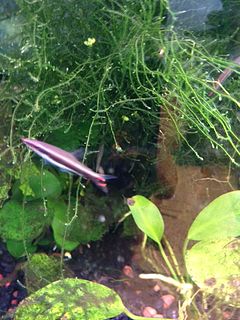 W
WNannostomus unifasciatus,, commonly known as the one-lined pencilfish, is a freshwater species of fish belonging to the genus Nannostomus in the characin family Lebiasinidae. They are popular in the aquarium trade due to their small size, beautiful color pattern, unique swimming posture and relative hardiness. With its long, pencil-shaped profile, its single jet black stripe reminiscent of the graphite core of a pencil, and its eraser-colored caudal fin, this is the species for which the popular name, 'pencilfish', was first coined in the 1920s, later to be applied to all the species of the genus Nannostomus.
 W
WParatrygon is a monotypic genus of the cartilaginous fish in the family of Potamotrygonidae. The sole currently recognized species is Paratrygon aiereba, the discus ray, manzana ray or ceja ray, from the Amazon and Orinoco basins in South America. Genetic and morphometric evidence suggests that P. aiereba as presently defined is a species complex.
 W
WPhysopyxis lyra is a species of thorny catfish found in the Essequibo and Amazon basins. It occurs in the countries of Brazil, Colombia, Guyana and Peru. This species grows to a length of 3.5 centimetres (1.4 in) SL. This species prefers to live amongst submerged organic debris.
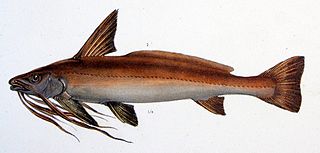 W
WPinirampus pirinampu is a species of catfish of the family Pimelodidae. P. pirinampu is also known as the flatwhiskered catfish.
 W
WPotamotrygon orbignyi, or the smooth back river stingray, is a species of river stingray in the family Potamotrygonidae. It is found in the Amazon and Orinoco River basins in South America.
 W
WPseudacanthicus is a genus of medium to large-sized suckermouth armored catfishes native to South America, where found in the Amazon and Orinoco basins, as well as rivers of the Guianas. They are primarily found in fast-flowing waters, sometimes relatively deep. They are sometimes kept in aquariums.
 W
WPseudacanthicus leopardus is a species of armored catfish endemic to Guyana where it occurs in the Rupununi River basin. This species grows to a length of 15 centimetres (5.9 in) TL.
 W
WPseudoplatystoma fasciatum or barred sorubim or barred catfish is a species of long-whiskered catfish native to the Suriname, Corantijn and Essequibo. The nocturnal predator feeds mainly on other fish and crabs. Females reach a more notable size. They become sexually mature at 56 cm (22 in), males at 45 cm (18 in) and this species reaches a maximum length of 90 cm (35 in) TL. Fecundity seems to be estimated at 8 million eggs per kg, but was recently measured in aquaculture at a lower, and more likely number of 150,000 eggs laid per kg.
 W
WPterophyllum scalare, most commonly referred to as angelfish or freshwater angelfish, is the most common species of Pterophyllum kept in captivity. It is native to the Amazon Basin in Peru, Colombia, and Brazil. Particularly to the Ucayali river in Peru, the Oyapock River in French Guiana, the Essequibo River in Guyana, the Solimões, the Amapá, and the Amazon rivers in Brazil. It is found in swamps or flooded grounds where vegetation is dense and the water is either clear or silty. Its native water conditions range from a pH of 6.0 to 7.0, a water hardness range of 3 to 10 °dH, and water temperature ranging from 26 to 30 °C. This is the species of angelfish most frequently found in the aquarium trade. A similar P. scalare exists in the Orinoco. They are of the same size and shape, the only difference being its stripes: the Orinoco P. scalare has thinner, but dual stripes.
 W
WThe daggernose shark is a little-known species of requiem shark, in the family Carcharhinidae, and the only extant member of its genus. It inhabits shallow tropical waters off northeastern South America, from Trinidad to northern Brazil, favoring muddy habitats such as mangroves, estuaries, and river mouths, though it is intolerant of fresh water. A relatively small shark typically reaching 1.5 m (4.9 ft) in length, the daggernose shark is unmistakable for its elongated, flattened, and pointed snout, tiny eyes, and large paddle-shaped pectoral fins.
 W
WThe silver arowana is a South American freshwater bony fish of the family Osteoglossidae. Silver arowanas are sometimes kept in aquariums, but they are predatory and require a very large tank.
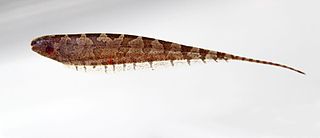 W
WSteatogenys elegans, the barred knifefish, is a species of Hypopomidae found in tropical South America. It is the type species of its genus. It is an electric fish found in a wide range of freshwater habitats in the Amazon, Orinoco and Essequibo river basins. It reaches almost 30 cm (1 ft) in total length.
 W
WThe sharpsnout stingray or wingfin stingray is a species of stingray in the family Dasyatidae, found from off Venezuela to northern Brazil. It inhabits shallow, brackish water, shifting towards the coast in the dry season and away from it in the rainy season. Typically measuring 70 cm (28 in) across, this dark brown ray is easily identifiable by its long, projecting snout and elongated, acutely pointed pelvic fins. Its diet consists of bottom-dwelling invertebrates. Reproduction is aplacental viviparous, with females bearing one to three pups annually. Naturally uncommon and slow-reproducing, the sharpnose stingray is under pressure by both artisanal and commercial fisheries, leading the International Union for Conservation of Nature (IUCN) to assess it as Near Threatened.
 W
WTrachydoras microstomus is a species of thorny catfish that is native to Bolivia, Brazil, Colombia, Guyana, Peru and Venezuela. It occurs in the Essequibo, Orinoco and Amazon basins. This species grows to a length of 5.9 centimetres (2.3 in) SL.